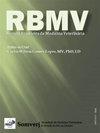马噬线虫真菌musiformarthrobotrys和Monacrosporium sinense的体内外生物防治研究
Q4 Veterinary
引用次数: 2
摘要
研究了真菌musiformarthrobotrys (A144分离物)和Monacrosporium sinense (SF53分离物)对cyathostomins的控制作用。在体外,将含2%水琼脂的培养皿分为两组:1组(A144 + SF53);2 (SF53);3 (A144);4(对照组)。在体内,24只动物接受了含有真菌菌丝体的颗粒。将动物分为四组:1组(100 g含A144 + SF53分离物的颗粒);2(含分离物A144的微球100 g);3(含SF53分离物的微球100 g);4(无真菌颗粒)。分别于给药后12、24、36、48、60和72小时收集粪便。与对照组相比,分离菌的体外联合可使L3降低69.7%;分离物A144使L3降低77.3%;SF53分离物使L3降低84.3%。在体内,真菌A. musiformis和M. sinense对cyathostomins的L3具有捕食性,捕食性范围为63.2% ~ 83%。真菌A. musiformis和M. sinense在体外和体内均能有效控制胞口蛋白L3。本文章由计算机程序翻译,如有差异,请以英文原文为准。
Association of the nematophagous fungi Arthrobotrys musiformis and Monacrosporium sinense in vitro and in vivo for biological control of equine cyathostomins
The fungi Arthrobotrys musiformis (A144 isolate) and Monacrosporium sinense (SF53 isolate) were evaluated for controlling L3 of cyathostomins. In vitro , Petri dishes containing 2% water-agar were divided into groups: 1 (A144 + SF53); 2 (SF53); 3 (A144); 4 (control group). In vivo , 24 animals received pellets containing fungal mycelium. The animals were divided into four groups: 1 (100 g of pellets containing A144 + SF53 isolates); 2 (100 g of pellets containing A144 isolate); 3 (100 g of pellets containing SF53 isolate); 4 (Pellets without fungi). Feces were collected at 12, 24, 36, 48, 60 and 72 hours after pellet administration. The association of isolates, in vitro , was able to reduce L3 by 69.7%, compared with the control group; A144 isolate reduced L3 by 77.3%; and SF53 isolate reduced L3 by 84.3%. In vivo , the association of fungi A. musiformis and M. sinense showed predatory activity against L3 of cyathostomins with efficacy ranged from 63.2% to 83%. The association of the fungi A. musiformis and M. sinense both in vitro and in vivo proved to be efficient for controlling L3 of cyathostomins.
求助全文
通过发布文献求助,成功后即可免费获取论文全文。
去求助
来源期刊
CiteScore
0.80
自引率
0.00%
发文量
34
审稿时长
>12 weeks
期刊介绍:
The Brazilian Journal of Veterinary Medicine was launched in 1979 as the official scientific periodical of the Sociedade de Medicina Veterinária do Estado do Rio de Janeiro (SOMVERJ). It is recognized by the Sociedade Brasileira de Medicina Veterinária (SBMV) and the Conselho Regional de Medicina Veterinária do Estado do Rio de Janeiro (CRMV-RJ).

 求助内容:
求助内容: 应助结果提醒方式:
应助结果提醒方式:


